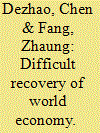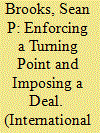| Srl | Item |
| 1 |
ID:
158907


|
|
|
|
|
| Summary/Abstract |
This paper comprehensively reviews China's openness since 1978 from three aspects: trade, foreign investment and global production sharing. We point out that the economic development of China is now standing at a historic turning point. Specifically, economic changes in China are discussed from four dimensions: (i) from China being a world assembly line to a world manufacturing powerhouse; (ii) from China being a world capital receiver to a world investor; (iii) from China being a world factory to a world market; and (iv) from the situation of “made in China” to “innovated in China.” At the same time, the global economic system has also reached a turning point. A “North America–Europe–Asia” tri‐polar system has formed, in which the USA, Germany and China, respectively, serve as the regional core economies.
|
|
|
|
|
|
|
|
|
|
|
|
|
|
|
|
| 2 |
ID:
114105


|
|
|
| 3 |
ID:
084355


|
|
|
|
|
| Publication |
2008.
|
| Summary/Abstract |
Low expectations and international impatience forced the African Union to shift from a classical integrative approach to negotiations to "deadline diplomacy" during the final months of the Abuja talks between the Sudanese government and the Darfur rebel movements. As a result, the AU mediators - who had served as communicators and formulators - assumed the responsibility of manipulators. This transition scuttled plans for gradually arriving at the implementing details for a formula. Instead, acquiescence to power served as the chief reason for the signature of one of the movements, while the mediators showed disinterest and inflexibility in reigning in the other two movements that required a package of additional threats and inducements. Important lessons regarding the credibility of deadlines, the appropriateness of the formula, the necessity of ownership, inclusivity/exclusivity of the talks, and sufficient support for the movements in the prenegotiation and diagnosis phases can be drawn from the Abuja process.
|
|
|
|
|
|
|
|
|
|
|
|
|
|
|
|
| 4 |
ID:
149896


|
|
|
|
|
| Summary/Abstract |
The Environmental Kuznets Curve (EKC) is a widely applied empirical model that is used to assess the effect of country's increased income on its emissions (such as CO2). Typical estimation is of a reduced form model relating per capita emissions to per capita GDP (and sometimes to energy consumption) with an eye toward determining whether a country's per capita emissions increase or decrease with per capita GDP. In this article, we consider a number of practical issues in estimating and using the EKC for energy policy analysis. Proper estimation procedures should be used if the empirical work is to provide valid estimates of the EKC's shape. In addition, policymakers should proceed with caution when crafting policy on the basis of reduced form estimates of the EKC because the reduced form model provides limited insight into the policy implications of the relationship between income, energy consumption and emissions.
|
|
|
|
|
|
|
|
|
|
|
|
|
|
|
|